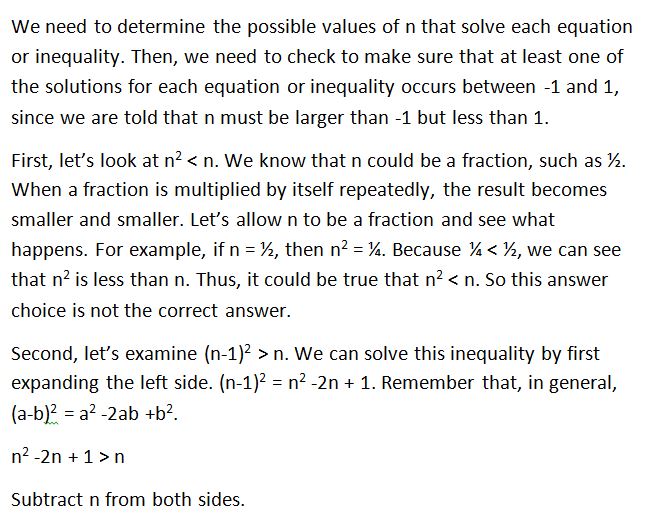How to find the solution to an inequality with multiplication
Help Questions
PSAT Math › How to find the solution to an inequality with multiplication
Which of the following numbers could be a solution to the inequality 
Explanation
In order for a negative multiple to be greater than a number and a positive multiple to be less than that number, that number must be negative itself. -4 is the only negative number available, and thus the correct answer.
What is the least value of 
a true statement?
Explanation
Find the solution set of the three-part inequality as follows:
The least possible value of 
We have 
Explanation
Give the solution set of the inequality:
None of the other responses gives the correct answer.
Explanation
Divide each of the three expressions by 

or, in interval form,
![\left ( 5\frac{1}{3}, 9 \frac{1}{3} \right ]](https://vt-vtwa-assets.varsitytutors.com/vt-vtwa/uploads/formula_image/image/230643/gif.latex)
Give the solution set of the following inequality:
None of the other responses gives the correct answer.
Explanation
or, in interval notation, 
What is the greatest value of 
a true statement?
Explanation
Find the solution set of the three-part inequality as follows:
The greatest possible value of 
If –1 < n < 1, all of the following could be true EXCEPT:
n2 < n
|n2 - 1| > 1
(n-1)2 > n
16n2 - 1 = 0
n2 < 2n
Explanation
Fill in the circle with either 




None of the other answers are correct.
The rational expression is undefined.
Explanation
Let us simplify the second expression. We know that:
So we can cancel out as follows:
(√(8) / -x ) < 2. Which of the following values could be x?
All of the answers choices are valid.
-4
-3
-2
-1
Explanation
The equation simplifies to x > -1.41. -1 is the answer.
Solve for x























![\left ( 5\frac{1}{3}, 9 \frac{1}{3} \right ]](https://vt-vtwa-assets.varsitytutors.com/vt-vtwa/uploads/formula_image/image/230590/gif.latex)

![\left (3, 5 \frac{1}{4} \right ]](https://vt-vtwa-assets.varsitytutors.com/vt-vtwa/uploads/formula_image/image/230592/gif.latex)














































